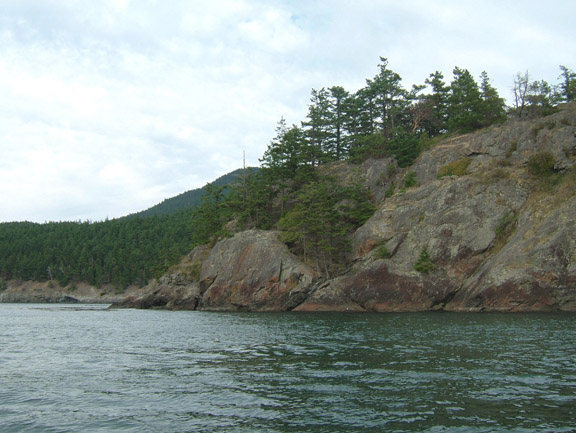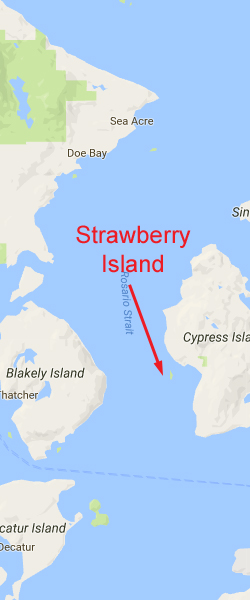Double click to edit

Strawberry Island
Topography: Expansive wall and rocky faces that drops down to over 140 feet.
San Juan Islands marine life rating: 4
San Juan Islands structure rating: 4
Diving depth: 70-100 feet.
Highlight: Dense and diverse marine life packed on expansive walls and shelves.
Skill level: Advanced
GPS coordinates: N48° 33.795’ W122° 44.208’
Access by boat: Strawberry Island is a small island in the Rosario Strait. It marks the outskirts of Strawberry Bay on the west side of Cypress Island. The entire west side of this island makes up this expansive dive site, although I normally dive the northern half.
Shore access: None
Dive profile: I start my dives at the north tip of the island just inside the kelp. I drift south on the current and use the rocky structure along the way as shelter when I want to stop and look at some of the marine life. Numerous rockfish hunker down in these sheltered areas when current is present. Although large sections of this wall consist of sheer rock sheets that offer no sanctuary from the current, I usually don’t have to look too far to find some protrusion, ridge, boulder, or ledge that I can hide behind. Rows of giant plumose anemones often line the leeward edges of ridges that provide some shelter from the current. The current subsides about mid-island allowing me to freely explore.
Sheer rock faces, tall walls, large ledges, huge crevices, and boulder fields dominate the underwater substrate to the north. The structure turns from vertical to horizontal just over half way down the island as sheerness gives way to a large shelf that continues south. The shelf eventually yields to a very deep wall at the very south end of the island. Current on the south wall can be very intense.
Thick bull kelp grows at both ends of the island. Smaller groves of bull kelp are found along the wall. I end my dive halfway down the side of the island in a current free area and perform my safety stop in a small grove of bull kelp.
Visibility in the Rosario Strait is often poor compared to some of the other dive San Juan Island dive sites. I expect about 10-25 feet of visibility when diving Strawberry Island.
My preferred gas mix: EAN 36
Current observations:
Current Station: Strawberry Island, 0.8 miles West
Noted Slack Corrections: None
Strawberry Island is a current intensive site. I only drift dive this site with divers who are comfortable dealing with variable current throughout the dive. The current pushes south along the wall regardless if the tide is ebbing or flooding. Upwelling and waterfalling occurs as the current deflects off protruding structure.
The only time current has not been a factor is during very minor exchanges (0.75 knots at maximum). Standing tide rips are often visible at either end of the Strawberry Island when substantial current is present. I expect the first half of my dive to be a drift dive when the tide rips are present.
Hazards:
Current: Strong current is prevalent at the north and south ends of the island. The current is often persistent along the north section of the wall, even at slack. Upwelling and waterfalling can occur along the wall. Potentially dangerous tide rips are often present at both ends of the island.
Depth: Sections of this site consist of sheer walls that drop below safe recreational scuba limits. Good buoyancy and depth management skills are a must.
Boat launches:
Washington Park. Approximately six miles from the dive site. This park offers a good boat launch with docks, restroom facilities, and camping. Parking with a trailer during summer months can be very tight, although some parking is reserved for day use.
Marine life: The substrate along this wall is not heavily blanketed in thick silt like Sares Head. Strawberry Island offers a relatively clean ecosystem allowing many invertebrates to thrive uninhibited.
Green sea urchins feed vigorously in the shallows on kelp. Deeper down lives the green sea urchins larger cousins, the red and purple sea urchin.
Countless reddish-orange slipper sea cucumbers are densely packed in sections of the wall. Matching the sea cucumbers in numbers are thousands of swimming scallops encrusted with yellow or purple sponges. Legions of giant plumose anemones cling to boulders or ledges where they can get at least some shelter from the torrid current. Florescent pink crimson anemones add even more vibrancy and serve as sanctuary for tiny candy stripe shrimp. Multicolor urticina anemones the size of dinner plates dot walls and shelf areas. Joining this extravaganza are yellow branching sponges, glassy sea squirts, burrowing sea cucumbers, yellow encrusting sponges - the list goes on and on. And don’t be surprised when you run into a giant Pacific octopus on a ledge or hiding in one of the boulder fields.
Fish populations include healthy reserves of copper, quillback, and Puget Sound rockfish. Lingcod, cabezon, painted greenling, longfin sculpins, red Irish lords, kelp greenling and wolfeels are all residents of this wall.
San Juan Islands marine life rating: 4
San Juan Islands structure rating: 4
Diving depth: 70-100 feet.
Highlight: Dense and diverse marine life packed on expansive walls and shelves.
Skill level: Advanced
GPS coordinates: N48° 33.795’ W122° 44.208’
Access by boat: Strawberry Island is a small island in the Rosario Strait. It marks the outskirts of Strawberry Bay on the west side of Cypress Island. The entire west side of this island makes up this expansive dive site, although I normally dive the northern half.
Shore access: None
Dive profile: I start my dives at the north tip of the island just inside the kelp. I drift south on the current and use the rocky structure along the way as shelter when I want to stop and look at some of the marine life. Numerous rockfish hunker down in these sheltered areas when current is present. Although large sections of this wall consist of sheer rock sheets that offer no sanctuary from the current, I usually don’t have to look too far to find some protrusion, ridge, boulder, or ledge that I can hide behind. Rows of giant plumose anemones often line the leeward edges of ridges that provide some shelter from the current. The current subsides about mid-island allowing me to freely explore.
Sheer rock faces, tall walls, large ledges, huge crevices, and boulder fields dominate the underwater substrate to the north. The structure turns from vertical to horizontal just over half way down the island as sheerness gives way to a large shelf that continues south. The shelf eventually yields to a very deep wall at the very south end of the island. Current on the south wall can be very intense.
Thick bull kelp grows at both ends of the island. Smaller groves of bull kelp are found along the wall. I end my dive halfway down the side of the island in a current free area and perform my safety stop in a small grove of bull kelp.
Visibility in the Rosario Strait is often poor compared to some of the other dive San Juan Island dive sites. I expect about 10-25 feet of visibility when diving Strawberry Island.
My preferred gas mix: EAN 36
Current observations:
Current Station: Strawberry Island, 0.8 miles West
Noted Slack Corrections: None
Strawberry Island is a current intensive site. I only drift dive this site with divers who are comfortable dealing with variable current throughout the dive. The current pushes south along the wall regardless if the tide is ebbing or flooding. Upwelling and waterfalling occurs as the current deflects off protruding structure.
The only time current has not been a factor is during very minor exchanges (0.75 knots at maximum). Standing tide rips are often visible at either end of the Strawberry Island when substantial current is present. I expect the first half of my dive to be a drift dive when the tide rips are present.
Hazards:
Current: Strong current is prevalent at the north and south ends of the island. The current is often persistent along the north section of the wall, even at slack. Upwelling and waterfalling can occur along the wall. Potentially dangerous tide rips are often present at both ends of the island.
Depth: Sections of this site consist of sheer walls that drop below safe recreational scuba limits. Good buoyancy and depth management skills are a must.
Boat launches:
Washington Park. Approximately six miles from the dive site. This park offers a good boat launch with docks, restroom facilities, and camping. Parking with a trailer during summer months can be very tight, although some parking is reserved for day use.
Marine life: The substrate along this wall is not heavily blanketed in thick silt like Sares Head. Strawberry Island offers a relatively clean ecosystem allowing many invertebrates to thrive uninhibited.
Green sea urchins feed vigorously in the shallows on kelp. Deeper down lives the green sea urchins larger cousins, the red and purple sea urchin.
Countless reddish-orange slipper sea cucumbers are densely packed in sections of the wall. Matching the sea cucumbers in numbers are thousands of swimming scallops encrusted with yellow or purple sponges. Legions of giant plumose anemones cling to boulders or ledges where they can get at least some shelter from the torrid current. Florescent pink crimson anemones add even more vibrancy and serve as sanctuary for tiny candy stripe shrimp. Multicolor urticina anemones the size of dinner plates dot walls and shelf areas. Joining this extravaganza are yellow branching sponges, glassy sea squirts, burrowing sea cucumbers, yellow encrusting sponges - the list goes on and on. And don’t be surprised when you run into a giant Pacific octopus on a ledge or hiding in one of the boulder fields.
Fish populations include healthy reserves of copper, quillback, and Puget Sound rockfish. Lingcod, cabezon, painted greenling, longfin sculpins, red Irish lords, kelp greenling and wolfeels are all residents of this wall.

